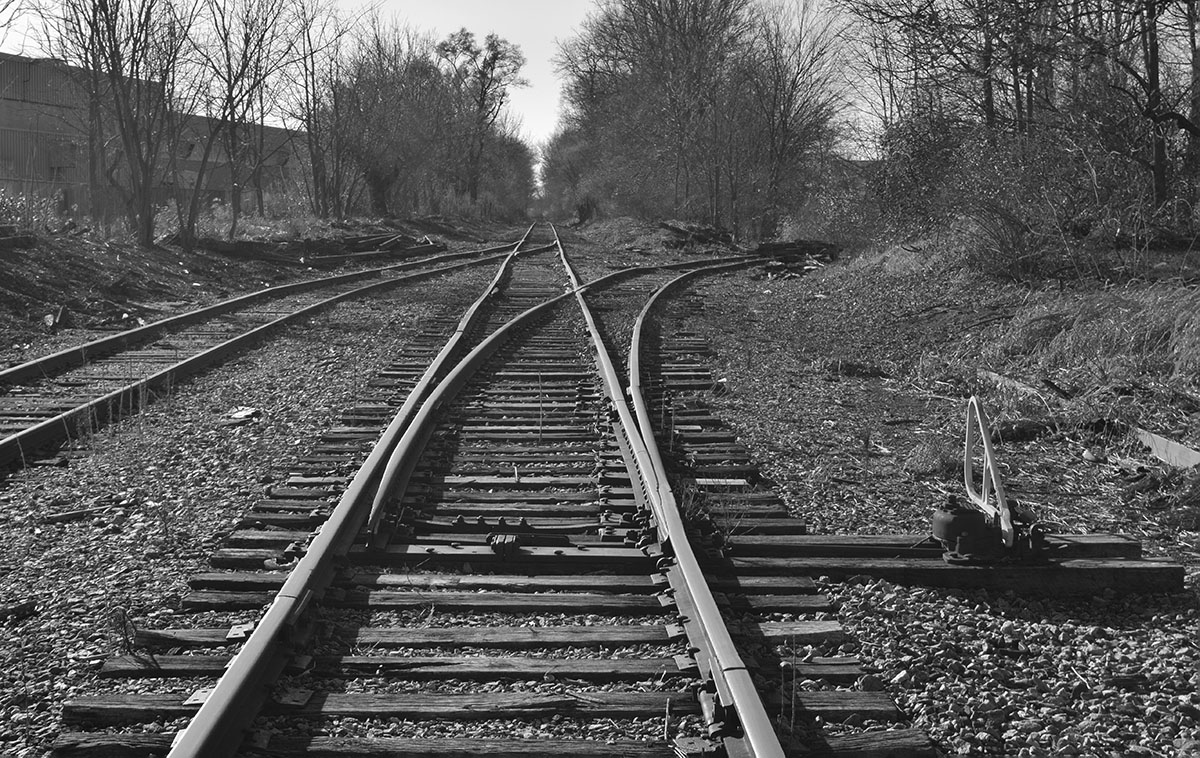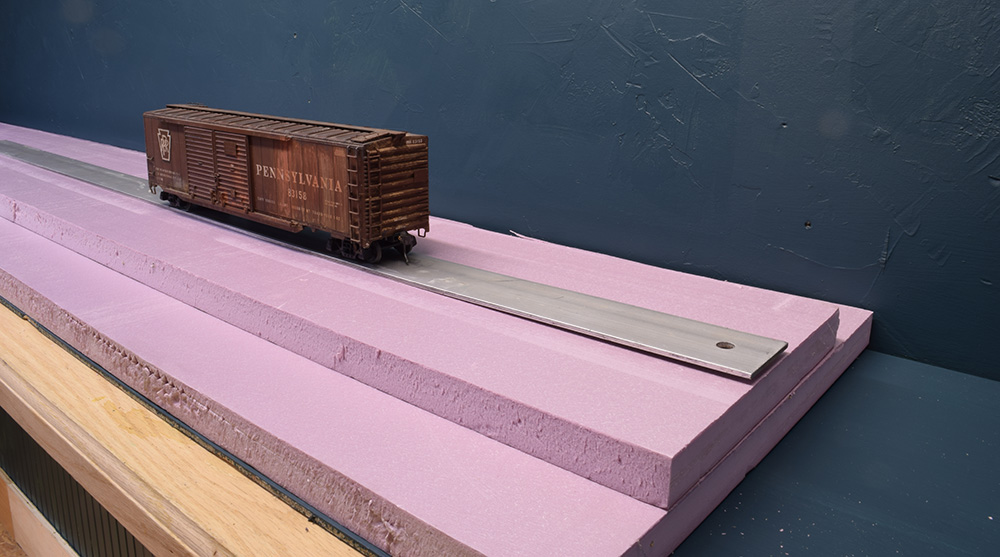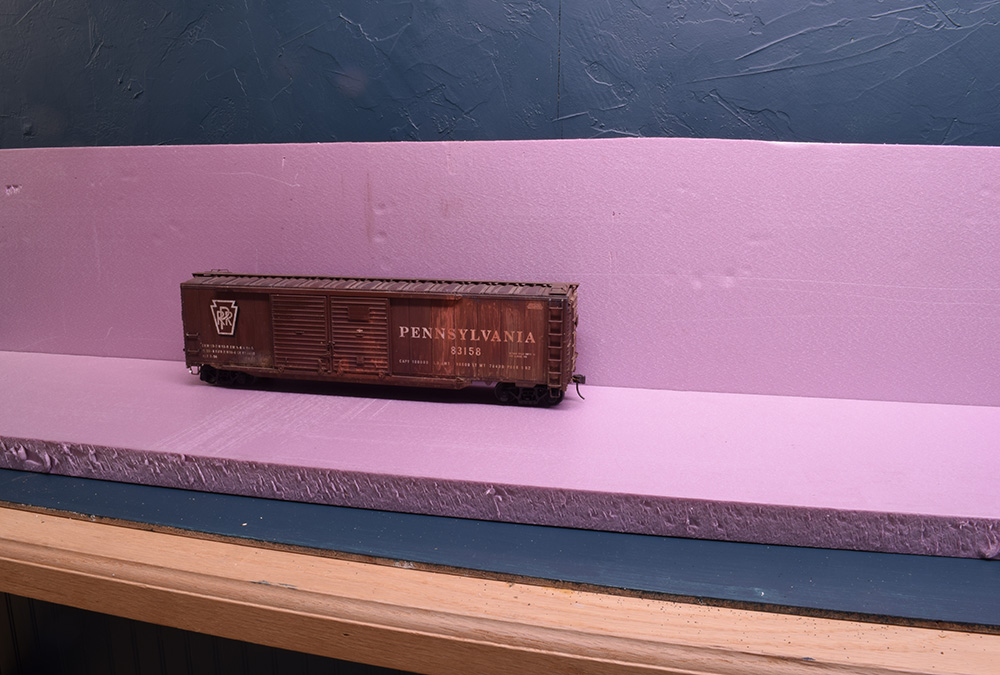The inspiration for this new work is a single track industrial branch serving one or two remaining customers. Richmond has the remnant of the former GR&I that serves a wire and cable plant (photo below), while Youtube overflows with other examples. Just search for switching videos and you’re certain to find something of interest.
I only want a modest amount of track and scenery to convey the atmosphere of a line that sneaks past rear yards and other transitory spaces on its journey from one place to another.

This remnant of the former GR&I serves as a short industrial branch that tiptoes through dense woods, while passing quietly by back yards of the surrounding neighborhoods. The spur to the right is abandoned. The track on the left is the runaround with an active spur to the wire and cable plant in the background.
To provide a sense of distance the track will pass through a variety of spaces. Some wide open and others tightly restricted that will require the train to go cautiously. Surfaces will range from ties buried in dirt and weeds, track in pavement and other scenarios that suggest the idea of moving through a range of local conditions.

Track that traverses a variety of surfaces give the impression of time and distance as one travels through a series of distinct places.
Design For Time
A key factor in many of the videos I’ve watched is how local conditions impose upon the train’s movements. Busy urban grade crossings with impatient drivers dictate the train stop and flag traffic before entering the crossing itself. Sketchy track conditions and restricted clearances require care in running and increased situational awareness of what’s happening around and ahead of you. These aspects add time which also translates to the perceived sense of distance traveled. The more I study these operations, I realize what a missed opportunity this is. We can intentionally design for time spent. Examples of this include the common grade crossing congestion but also time to unlock and open security gates, walking the train, speed restricted trackage, waiting for a vehicle that’s blocking the tracks to be moved and countless other everyday chores we willfully ignore in a mad rush to do …what?
Breaking The Tyranny of The Rectangle
I’m treating these scenes as distinct cameos that will link together. Each one will only use the amount of space the featured modeling requires. I envision no section wider than twelve inches at most, with the majority less than that dimension. A single track in P48 for example, will fit easily on an eight inch wide base that provides a modest amount of scenery on each side for context. These discrete scenes are designed as self-contained compositions that sit on an independent support surface like a shelf or countertop. They are larger versions of the small dioramas I made a few years ago.

(Photo above) The usual layer cake approach to foam construction wastes a lot of material. Even at a modest 16 inch depth in quarter-inch scale, why do we need so much scenery on either side of a single track?
(Photo below) For a warehouse siding, the overall depth of the scene is quite shallow. As on the former 13th and North E Street cameo, the vertical piece of foam in this mockup suggests that a building flat with hidden edges is more than enough to convey the desired realism of a huge structure.

Simplicity Drives This Design
Throughout the series, I’ve tried to share the idea that this craft is only limited by your own imagination. Rather than blindly copying a long forgotten time and place, I see this work as a form of interpretation. I want to focus on the aspects of railroading that I’m drawn to and use all of the creative skills I’ve developed to say something about them. As an artist, this is a natural progression. You study a subject over time and at first, simply copy it as best as you can. IF you stay with the subject long enough, you start thinking about your response to it and perhaps why it matters to you personally. In time you move on from copying and begin to interpret the subject. Trains have always been an introspective, up close and personal experience for me. These qualities keep me coming back time after time in an ongoing search for creative ways of expressing them.
With this work, I not only want to explore different construction forms but also strip away the non-essential clutter from the design. I want to highlight the images of a train slowly doing the work asked of it. In my choices of railroad subject matter and context, I’m saying this is how I see the world and what’s important to me. Maybe you could take a moment and have a look for yourself.
Regards,
Mike
“…why do we need so much scenery on either side of a single track?”
Because we have been repeatedly told that’s what we should do!
Which, I suppose, is the point of your blog: asking why we should continue to accept convention without questioning it…
HI Mike,
I like where you’re going with this discussion, and it has given me quite a bit to ponder. I have been finishing part of my basement and the space is roughly 13X19. I have some old modules that are 30 inches wide, and I placed them on each wall. Even though I have 8 feet of isle space between them, visually, they look ‘heavy,’ I instantly wanted to make them thinner, 24 inches wide but, maybe, I’ll take it further.
Hi Simon,
Getting readers to question convention was the intent of this blog from day one. -Mike
Hi Gordon,
I’m certain you’ll find a solution to the depth of your modules, whatever you come up with. -Mike
Mike,
I just finished an article that I think fits perfectly with the theme of your explorations in model railroading, The Secret to a Meaningful Life is Simpler Than You Think https://bit.ly/3ZvkIdx
While the entire article is a very good read, there is a segment toward the end that I think really touches on many of the themes you have been writing about: “Pursuing ends and goals… is all fine and good, yet that’s not really meaningful… Reflecting on why we pursue those goals is significant, however. By taking a reflective perspective, significance itself accrues. “This comes close to Socrates’ famous saying that the unexamined life is not worth living.””
The philosophical realm of model railroading is something that I never spent any time pondering before stumbling across your blog a few years ago. Thinking about the “whys” has really made the craft much more interesting to me, and completely changed my outlook and approach.
Thanks!